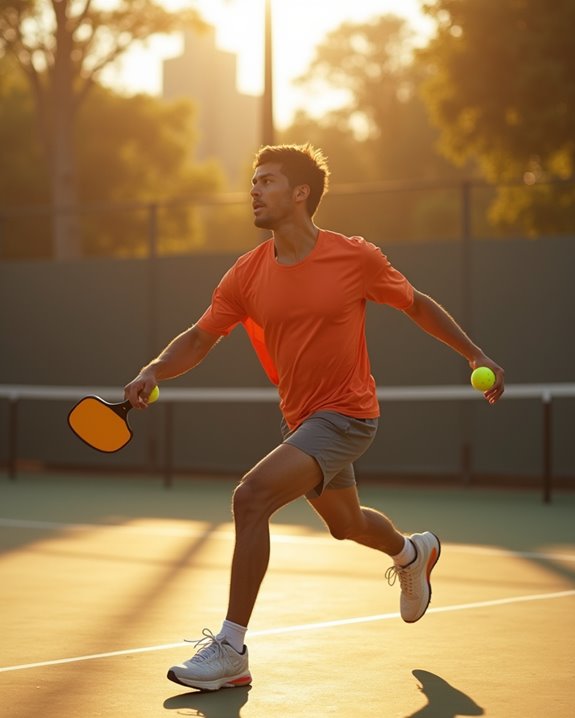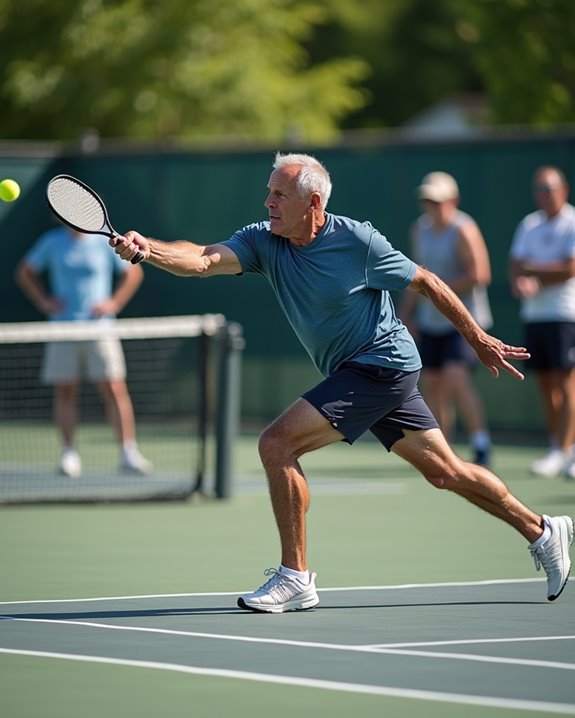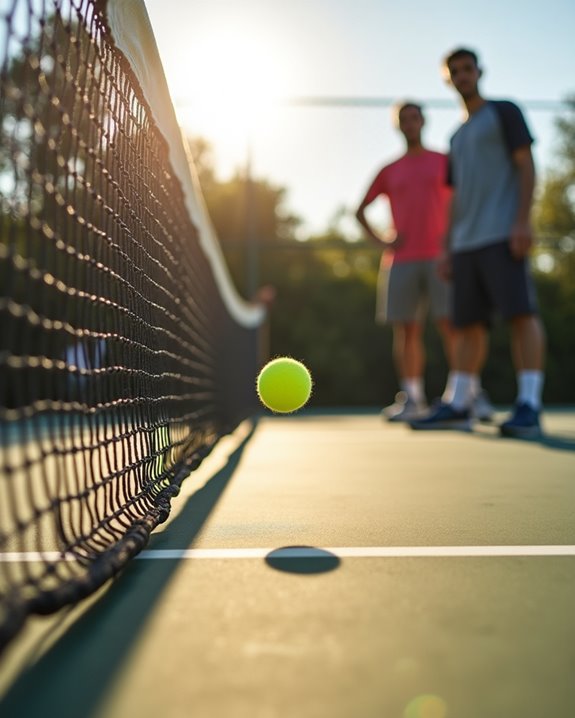In pickleball, the kitchen is a 7-foot non-volley zone extending from the net on both sides. You can’t volley the ball while inside this area or touching the kitchen line—the ball must bounce first. This 140-square-foot zone encourages strategic finesse over power plays. Position yourself behind the kitchen line when preparing for volleys, and practice dinking shots to maintain control. Master your footwork around this critical boundary to elevate your pickleball game.
Key Takeaways
- The kitchen is a 7-foot non-volley zone extending from the net where players cannot hit volleys.
- You can stand in the kitchen, but the ball must bounce before you hit it from this area.
- Touching the kitchen line while volleying is a fault—keep both feet behind the line.
- Momentum carrying you into the kitchen after a volley results in a fault.
- Positioning at the kitchen line creates offensive opportunities through strategic dinking shots.
What Is the Kitchen? Understanding the Non-Volley Zone
While pickleball enthusiasts love to smash and spike, you’ll need to mind your manners in “the kitchen”!
This critical 140-square-foot area extends 7 feet from each side of the net and serves as pickleball’s non-volley zone. Think of it as a no-fly zone for aggressive shots. You’re welcome to enter the kitchen, but you can’t volley the ball while standing in this zone—the ball must bounce first.
Be careful! If any part of your body or equipment touches the kitchen line while volleying the ball, you’ll serve up an instant fault. During serves, remember the kitchen line is off-limits too—your serve must clear this boundary to be valid. Mastering these pickleball rules transforms your game from raw to well-seasoned.
The Dimensions and Boundaries of the Kitchen
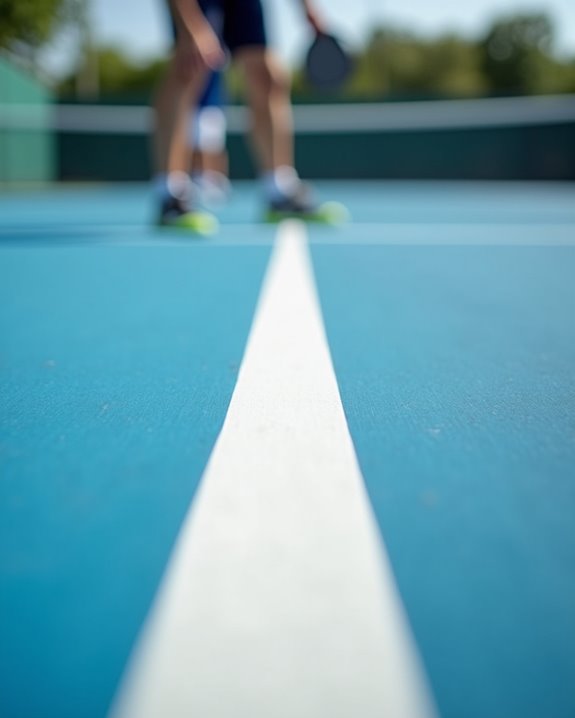
Three key measurements define the kitchen’s exact layout on your pickleball court. First, the non-volley zone extends 7 feet from the net on both sides—think of it as your prep space before the main cooking area. Second, the kitchen spans 20 feet across the entire width of the court, creating a rectangular zone where your footwork must be precise. Third, the total area of this critical zone is 140 square feet.
Key Kitchen Rules Every Beginner Should Know
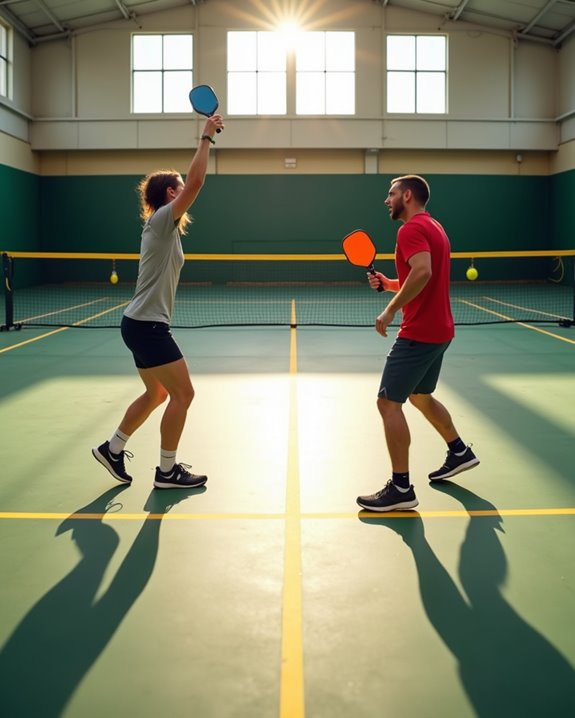
Now that you’re familiar with the kitchen’s dimensions, let’s plunge into the rules that’ll make or break your pickleball game! The non-volley zone isn’t just a boundary—it’s your recipe for strategic play.
Remember this golden rule: hitting a volley while standing in the kitchen is a fault. You must wait until the ball has bounced before striking it from within this zone. Think of it as letting your dough rise before baking!
It’s perfectly legal to volley the ball from behind the kitchen line, but be careful—momentum can be tricky! If any part of you touches the kitchen after volleying, you’ll serve up a fault. Even your paddle or clothing counts!
Master these kitchen rules and you’ll be cooking up victories in no time!
Common Kitchen Violations and How to Avoid Them
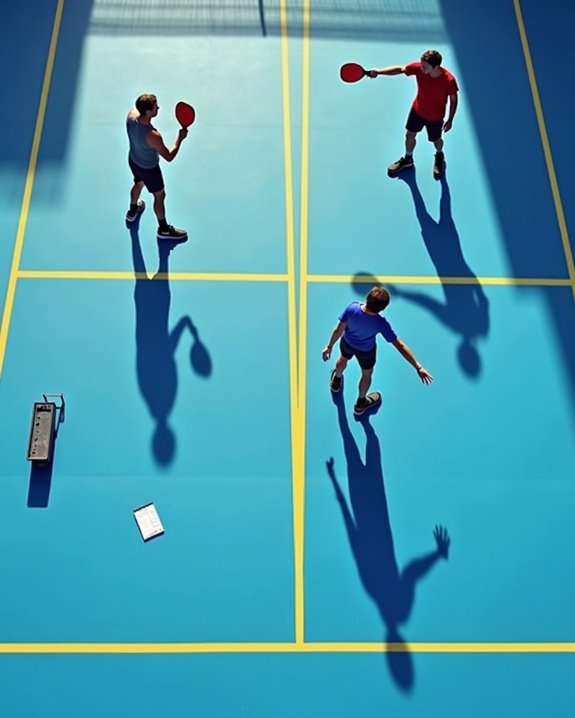
Even experienced players can get caught in the kitchen when they shouldn’t be! The most frequent violation occurs when you volley a ball (hit it before bouncing) while touching any part of the kitchen zone. Remember, the kitchen line is considered part of the kitchen—both feet must be completely outside this area before you strike that volley.
Watch your momentum! If you volley the ball and then your forward motion carries you into the kitchen, you’ve committed a fault. The rule is clear: you can’t touch the kitchen during or immediately after a volley.
To stay safe, position yourself a comfortable step behind the kitchen line when preparing for volleys. If you’re inside the kitchen, always let the ball bounce before you hit it.
Strategic Play Around the Kitchen Line

When you’ve mastered the rules of the kitchen, it’s time to transform this critical 7-foot zone into your strategic advantage! Position yourself at the kitchen line—the boundary of the non-volley zone—to serve up a feast of offensive opportunities.
The secret sauce to dominant pickleball? Dinking! This gentle shot keeps the ball low, forcing opponents to hit upward and giving you control of the rally. Think of dinking as simmering your strategy rather than boiling over with power shots.
For an extra spicy approach, practice the Erne—a legal volley executed while standing outside the kitchen. This move lets you slice shots at sharp angles while avoiding kitchen violations. Remember to exit the non-volley zone immediately after each shot, as lingering in this area can burn your chances of victory!
Mastering the Art of Dinking in the Kitchen
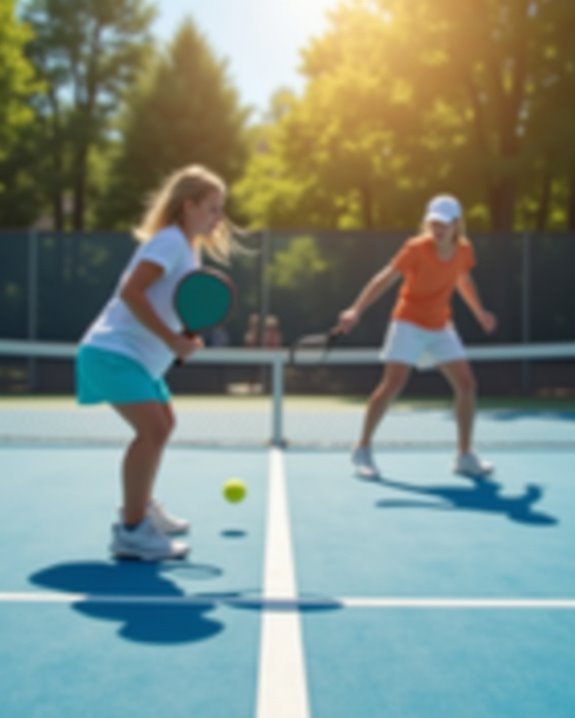
The gentle artistry of dinking deserves its own spotlight in your pickleball recipe book! This delicate shot is the perfect low-heat technique for maintaining control near the non-volley zone.
When you’re in the kitchen, remember you must let the ball bounce before you hit it—volleying while in this area is strictly forbidden. Think of dinking as folding egg whites into a soufflé—gentle precision is everything!
Skilled pickleball players use dinks to simmer the game’s tempo, forcing opponents into uncomfortable positions. Your goal? Place the ball just over the net with a soft touch, keeping it low like a perfectly reduced sauce. Master this technique, and you’ll transform from short-order cook to kitchen maestro, extending rallies and seasoning your game with strategic finesse.
When You Can (and Cannot) Enter the Kitchen
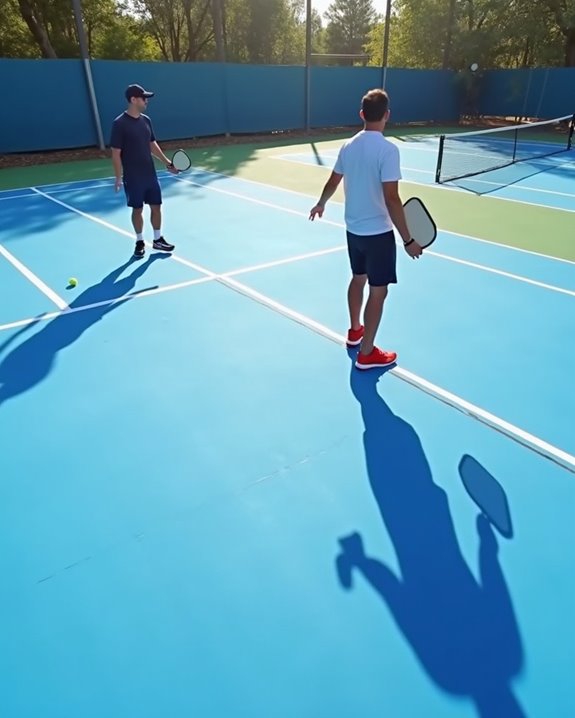
Three critical rules govern your relationship with the kitchen in pickleball, and mastering them will keep you from cooking up unnecessary faults!
First, you can enter the kitchen at any time, but you must wait for the ball to bounce before hitting it while in this non-volley zone. Think of it as letting your sauce simmer before stirring!
Second, when volleying the ball (hitting it before it bounces), both feet must remain completely outside the kitchen. Even touching the kitchen line while volleying serves up an instant fault.
Finally, watch your momentum! After volleying, you can’t let your forward motion carry you into the kitchen. Stay planted outside this 7-foot zone until your shot is complete and has cleared the net.
The Erne Shot: Advanced Kitchen Strategy

Now that you’ve mastered the kitchen rules, let’s spice up your game with a secret recipe the pros love! The Erne shot is a pickleball delicacy that allows you to volley without touching the non-volley zone.
Think of it as reaching over the kitchen counter to grab a tasty opportunity! You’ll position yourself outside the sideline while extending your pickleball paddle over the kitchen to strike the ball mid-air. This creates angles your opponents can’t digest easily.
For perfect execution, your timing must be as precise as following a soufflé recipe. Watch for players to play deep shots, then dash to the kitchen line—without touching it! This technique requires quick footwork and careful positioning, but once mastered, you’ll serve up shots that leave your opponents hungry for answers.
Why the Kitchen Exists: The Strategic Purpose in Pickleball

Pickleball’s kitchen serves as the game’s ultimate equalizer—similar to how salt balances flavors in cooking. This non-volley zone prevents physically dominant players from camping at the net and smashing every return. When you’re playing pickleball, you’ll notice how the kitchen creates a strategic area that rewards finesse over power.
The 7-foot zone demands precise shot placement and footwork, fundamentally folding skill back into the recipe. You’re required to let the ball bounce before entering this zone, which naturally encourages longer, more tactical rallies. Near the kitchen, you can execute delicious soft shots like dinks that keep opponents guessing. It’s where the game simmers rather than boils—creating a balanced experience where strategy trumps strength.
Frequently Asked Questions
What Is the Kitchen Rule in Pickleball?
In the 7-foot non-volley zone, you can’t volley while touching the kitchen line. Perfect your kitchen positioning and footwork to avoid kitchen violations. Practice kitchen drills to master kitchen strategies and maintain proper kitchen etiquette.
Can I Step in the Kitchen Before the Ball Bounces?
Yes, you can step in the kitchen anytime, but be careful about common mistakes and foot faults. Kitchen violations explained: you can’t volley while in or touching the kitchen – this is what kitchen strategy tips emphasize.
What Is the Rule of Dinking in the Kitchen?
When dinking in the kitchen, you must wait for the ball to bounce before hitting it. Proper footwork and positioning at the kitchen line helps your shot selection. Practice dink drills to improve your kitchen strategy.
How to Get Better at the Kitchen Pickleball?
Like a ballet dancer at the edge of a stage, you’ll master the kitchen through dedicated footwork drills, strategic shot placement, and focused practice routines. Improve your game awareness and player positioning with daily kitchen strategies.


